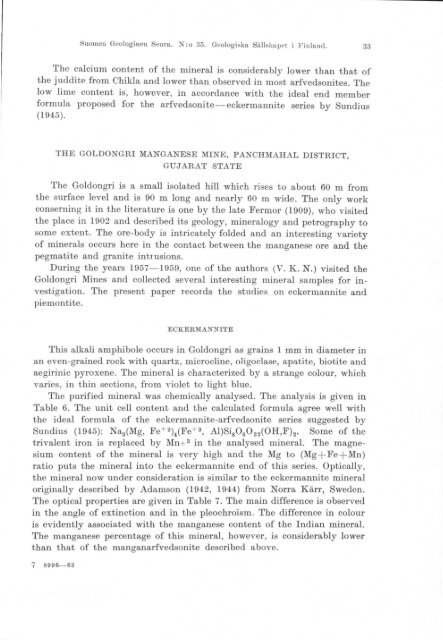COMMISSION GEOLOGIOUE - Arkisto.gsf.fi
COMMISSION GEOLOGIOUE - Arkisto.gsf.fi
COMMISSION GEOLOGIOUE - Arkisto.gsf.fi
Create successful ePaper yourself
Turn your PDF publications into a flip-book with our unique Google optimized e-Paper software.
Suomeu Geologiueu Seura. N:o 35. Geologiska Sällskapet i }'inlund. 33<br />
The calcium content of the mineral is considerably lower than that of<br />
the juddite from Chikla and lower than observed in most arfvedsonites. The<br />
low lime content is, however, in accordance with the ideal end member<br />
formula proposed for the arfvedsonite-eckermannite series by Sundius<br />
(1945).<br />
THE GOLDONGRI MANGANE SE MINE, PANCHMAHAL DISTRICT,<br />
GUJARAT STATE<br />
The Goldongri is a small isolated hill which rises to ab out 60 m from<br />
the surface level and is 90 m long and nearly 60 m wide. The only work<br />
conserning it in the literature is one by the late Fermor (1909), who visited<br />
the pI ace in 1902 and described its geology, mineralogy and petrography to<br />
so me extent. The ore-body is intricately folded and an interesting variety<br />
of minerals occurs here in the contact between the manganese ore and the<br />
pegmatite and granite intIUsions.<br />
During the years 1957- 1959, one of the authors (V. K. N.) visited the<br />
Goldongri Mines and collected several interesting mineral sampIes for investigation.<br />
The present paper records the studies on eckermannite and<br />
piemontite.<br />
ECKERMANNITE<br />
This alkali amphibole occurs in Goldongri as grains 1 mm in diameter in<br />
an even-grained rock with quartz, microcline, oligoclase, apatite, biotite and<br />
aegirinic pyroxene. The mineral is characterized by astrange colour, which<br />
varies, in thin sections, from violet to light blue.<br />
The puri<strong>fi</strong>ed mineral was chemically analysed. The analysis is given in<br />
Table 6. The unit cell conte nt and the calculated formula agree well with<br />
the ideal formula of the eckermannite-arfvedsonite series suggested by<br />
Sundius (1945): Naa{Mg, Fe+ 2 )4{Fe+ a , Al)SisOsOzz{OH,F}z. Some of the<br />
tri valent iron is replaced by Mn+ 3 in the analysed mineral. The magnesium<br />
content of the mineral is very high and the Mg to (Mg+Fe+Mn)<br />
ratio puts the mineral into the eckermannite end of this series. Optically,<br />
the mineral now under consideration is similar to the ecker mannite mineral<br />
originally described by Adamson (1942, 1944) from Norra Kärr, Sweden.<br />
The optical properties are given in Table 7. The main difference is observed<br />
in the angle of extinction and in the pleochroism. The difference in colour<br />
is evidently associated with the manganese content of the Indian mineral.<br />
The manganese percentage of this mineral, however, is considerably lower<br />
than that of the manganarfvedsonite described above.<br />
7 8996-63
















